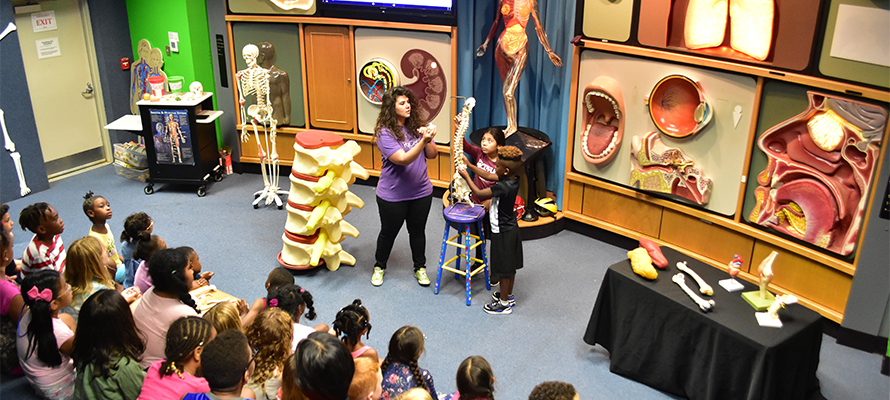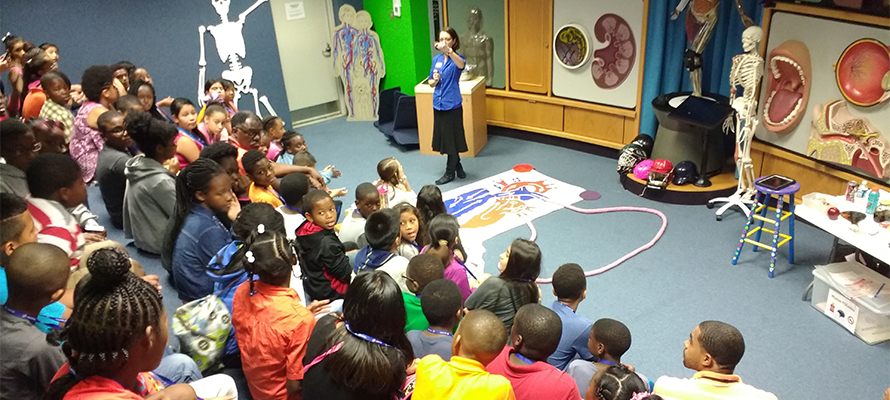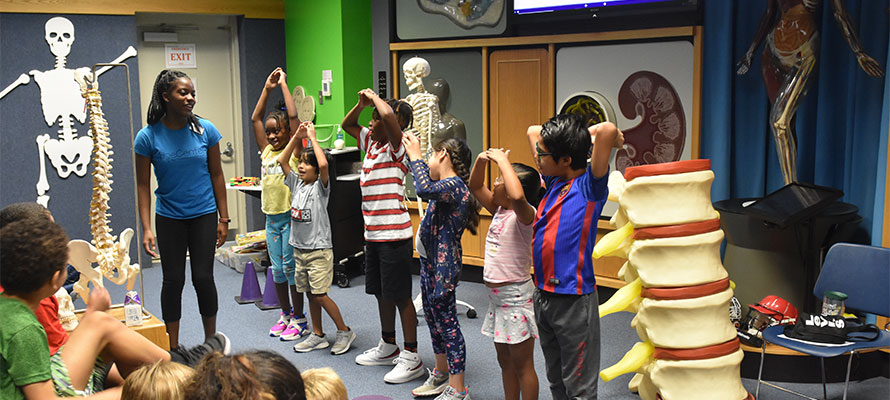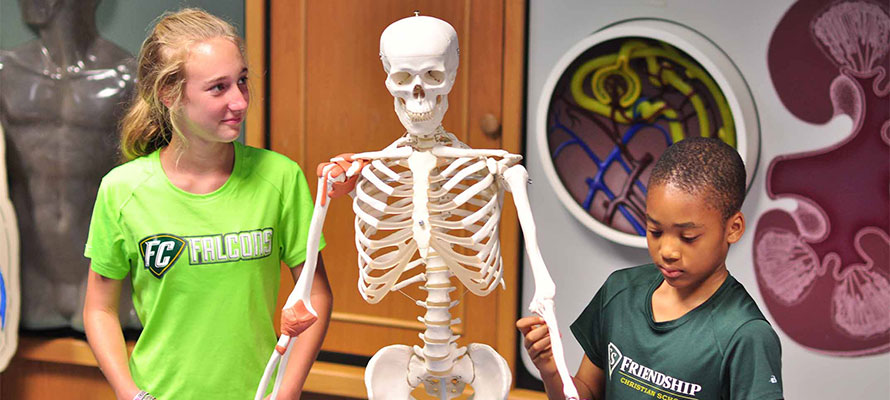General Health
General Health programs at the Poe Center educate children and youth on the major body systems and communicable diseases.
While our Transparent Anatomical Manikin (TAM) and her sidekick, SAM the Systems Man, are able to bring these topics to life at our Raleigh facility, their messages and information can be translated anywhere!




-
My Amazing Body!
Schedule this program for: Preschool,
My Amazing Body! is a program which introduces preschoolers to their personal responsibility for maintaining good health and taking care of their body. Special organs are highlighted as children meet a child-sized doll with removable parts, Cornelius P. Mud and the food puppets to introduce exercise, sleep and healthy eating.
Program Length: 30 minutesMeets NC DPI Healthful Living Essential Standards:-
- Kindergarten HPD-1: Children develop healthy eating habits.
- Kindergarten HPD-2: Children engage in active physical play indoors and outdoors.
- Kindergarten HPD-3: Children develop healthy sleeping habits.
-
-
Sunbeatables
Schedule this program for: Preschool, Kindergarten, 1st Grade,
In this curriculum, children meet the Ray and the Sunbeatables® superheroes, who travel around the world using their superpowers of sun protection. Children are encouraged to participate in activities to help Ray and his friends stay sun safe every day and everywhere they go.
Program Length: 30-45 minutes-
- Kindergarten
- K.PCH.1: Demonstrate age-appropriate personal behaviors that promote health and prevent disease.
- K.PCH.1.5: Select and use appropriate clothing according to the weather.
- K.PCH.2: Understand necessary steps to prevent and respond to unintentional injury.
- First Grade
- 1.PCH.1: List various personal behaviors and practices that promote health and prevent disease.
- 1.PCH.2: Understand necessary steps to prevent and respond to unintentional injury.
- Kindergarten
-
-
Germbusters (Junior)
Schedule this program for: Kindergarten, 1st Grade,
Germs, germs...they are not ALL bad, but they are tiny and they are everywhere! Are you ready to become a Germbuster? In this program participants will learn: where we can find various kinds of germs, how to prevent spreading germs, and how to have fun washing our hands. Join us and take the Germbuster pledge!
Program Length: 30-45 minutes-
- Kindergarten
- K.PCH.1: Demonstrate age-appropriate personal behaviors that promote health and prevent disease.
- First Grade
- 1.ANCOD.1: Understand household safety procedures for products and medicines with adult supervision.
- 1.PCH.1.1: Explain that germs produce illness and can be spread from one person to another.
- 1.PCH.1.2:Demonstrate measures for preventing the spread of germs.
- 1.PCH.2: Understand necessary steps to prevent and respond to unintentional injury.
- Kindergarten
-
-
Safety Smart
Schedule this program for: Kindergarten, 1st Grade,
You are someone special! Through a series of hands-on activities and games, this program illustrates the message of protecting yourself from the everyday hazards of daily activities at home, in our community, and identifying resources for help. Learn how to stay safe and healthy while still having fun!
Program Length: 45 minutesMeets NC DPI Healthful Living Essential Standards:-
- Kindergarten
- K.ANCOD.1: Understand household safety procedures for products and medicines with adult supervision.
- K.PCH.1: Demonstrate age-appropriate personal behaviors that promote health and prevent disease.
- K.PCH.1.1: Identify that healthy behaviors impact personal health.
- K.PCH.1.2: Use steps of correct hand washing at appropriate times throughout the day.
- K.PCH.2: Understand necessary steps to prevent and respond to unintentional injury.
- K.PCH.2.1: Recognize the meanings of traffic signs and safe practices for being a pedestrian and bicyclist.
- K.PCH.2.2: Explain the benefits of safety equipment including seat belts, booster seats, helmets, mouth guards, shin guards, and flotation devices.
- K.PCH.2.3: Illustrate how to get help in an emergency.
- K.PCH.2.4: Identify appropriate responses to warning signs, sounds, and labels.
- First Grade
- 1.PCH.1: List various personal behaviors and practices that promote health and prevent disease.
- 1.PCH.1.1: Explain that germs produce illness and can be spread from one person to another.
- 1.PCH.1.2: Demonstrate measures for preventing the spread of germs.
- 1.PCH.2: Understand necessary steps to prevent and respond to unintentional injury.
- 1.PCH.2.1: Identify and describe situations that cause injury.
- 1.PCH.2.2: Identify items that can cause burns and strategies to prevent fire and burn injury.
- 1.PCH.2.3: Execute the Stop, Drop, and Roll response.
- 1.PCH.2.4: Execute an emergency phone call.
- 1.ANCOD.1 Understand household safety procedures for products and medicines with adult supervision.
- Kindergarten
-
-
Summertime Safety
Schedule this program for: Kindergarten, 1st Grade, 2nd Grade, 3rd Grade, 4th Grade, 5th Grade,
Safe outdoor fun is the focus of this program. Children learn about protection from the sun, signs of overheating and dehydration, safe warm weather exercise and nutrition, poisonous plants, bug bites and more. Be active, stay safe, and have safe fun in the hot sun.
Program Length: 45 minutes-
- Kindergarten
- K.NPA.1: Identify sources of food and water and their importance to the body.
- K.NPA.1.1: Recognize that food gives us energy.
- K.NPA.2: State the importance of physical activity for the body.
- K.PCH.1: Demonstrate age-appropriate personal behaviors that promote health and prevent disease.
- K.PCH.2: Understand necessary steps to prevent and respond to unintentional injury.
- First Grade
- 1.PCH.1: List various personal behaviors and practices that promote health and prevent disease.
- 1.NPA.1.1: Name the reasons why we need to drink water.
- Second Grade
- 2.PCH.1.5: Explain the dangers associated with excessive sun exposure and methods for protecting oneself from these dangers.
- Third Grade
- 3.PCH.2.1: Demonstrate methods for prevention of common unintentional injuries.
- 3.PCH.2.2: Summarize methods that increase and reduce injuries in and around water.
- Fourth Grade
- 4.PCH.2.1: Identify personal protection equipment needed for sports or recreational activities.
- 4.PCH.3.2: Summarize habits to care for the skin.
- 4.NPA.2.2: List measures to prevent food borne illnesses, including washing hands and food storage methods.
- 4.NPA.3.2: Describe the benefits of drinking water before, during, and after physical activity.
- Fifth Grade
- 5.PCH.1.3: Discuss the benefits of sunlight, and the importance of taking measures to prevent sunburn.
- 5.PCH.2: Understand necessary steps to prevent and respond to unintentional injury.
- 5.PCH.2.1: Implement safety strategies to avoid causing injury to self and others.
- Kindergarten
-
-
Bones, Muscles and Joints
Schedule this program for: 2nd Grade, 3rd Grade,
Don’t be afraid of this skeletal session. Participants learn the function of bones and the importance of keeping them healthy. 3-D models illustrate how the bones support the body. Volunteers demonstrate how to keep the spine in-line.
Program Length: 60 minutesMeets NC DPI Healthful Living Essential Standards:-
- Second Grade
- 2.NPA.1: Explain where food and water come from and their importance to the body.
- 2.NPA.1.1: Explain the importance of eating a variety of foods from different groups according to the USDA.
- 2.NPA.1.2: Classify foods into groups according to USDA.
- 2.NPA.2: Examine the benefits of physical activity.
- 2.NPA.2.1: Explain why the body needs daily physical activity.
- Third Grade
- 3.PCH.1: Apply personal behaviors and practices that promote health and prevent disease.
- 3.PCH.2: Explain necessary steps to prevent and respond to unintentional injury.
- 3.PCH.2.1: Demonstrate methods for prevention of common unintentional injuries.
- 3.PCH.2.2: Summarize methods that increase and reduce injuries in and around water.
- 3.NPA.1: Recall why the body needs a variety of foods.
- 3.NPA.1.1: Recall the food groups and what foods are in each food group, according to the USDA.
- 3.NPA.3: Examine the benefits of physical activity.
- LS.3.1 Understand human body systems and how they are essential for life: protection, movement, and support.
- LS.3.1.1 Use models to infer the functions of the skeletal and muscular systems
- Second Grade
-
-
GermBusters
Schedule this program for: 2nd Grade, 3rd Grade,
They’re everywhere, they’re everywhere! What are we talking about? GERMS! Whether it’s cold and flu season or just close quarters, germs can spread easily. Through this interactive experience, empower your students with the knowledge to reduce the transmission of these microscopic organisms.
Program Length: 45 minutes-
- Second Grade
- 2.PCH.1: Explain personal behaviors and practices that promote health and prevent disease.
- 2.PCH.1.4: Demonstrate ways to prevent the spread of germs that cause common communicable diseases.
- 2.ANCOD.1: Understand household safety procedures for products and medicines with adult supervision.
- Third Grade
- 3.PCH.1: Apply personal behaviors and practices that promote health and prevent disease.
- 3.PCH.1.3: Explain the importance of personal hygiene in supporting one’s health.
- 3.ANCOD.1: Apply household safety procedures for products and medicines with adult supervision.
- Second Grade
-
-
Mission POE-ssible
Schedule this program for: 4th Grade, 5th Grade,
Take a journey to learn and explore the human body. Participants will identify several body systems as well as learn about what can affect these systems. Secret agents (participants) are tasked with a mission to defeat some of the saboteurs of our body systems. Agents have to make choices and answer questions along the way to complete the mission. The exhibits and activities provide the agents with opportunities to get into the concepts and see their systems “up close”. Participants explore myths and realities of sunscreen, learn the importance of protective equipment and learn about the spread of germs and food borne illnesses.
Program Length: 60 minutesMeets NC DPI Healthful Living Essential Standards:-
- Fourth Grade
- 4.PCH.1: Apply personal behaviors and practices that promote health and prevent disease.
- 4.PCH.2: Understand necessary steps to prevent and respond to unintentional injury.
- 4.PCH.3: Understand body systems and organs, their functions, and their care.
- 4.ANCOD.1: Understand health risks associated with the use of nicotine products.
- Fifth Grade
- 5.PCH.1: Utilize personal behaviors and practices that promote health and prevent disease.
- 5.PCH.2: Understand necessary steps to prevent and respond to unintentional injury.
- 5.PCH.3: Understand body systems and organs, functions, and their care.
- 5.ANCOD.1 Understand health risks associated with using alcohol, nicotine, cannabis, and other drugs.
- Fourth Grade
-
-
Body Machine
Schedule this program for: 9th Grade, 10th Grade, 11th Grade, 12th Grade,
Delve into the skeletal, circulatory, respiratory and digestive systems. Investigate key health concerns and identify current research on keeping the body healthy. Please note: Content and presentation are adjusted to suit the learning needs of 9th through 12th grade students.
Program Length: 60 minutesMeets NC DPI Healthful Living Essential Standards:-
- 9.PCH.1: Understand wellness, disease prevention, and recognition of symptoms.
- 9.PCH.1.1: Identify controllable versus uncontrollable risk factors for communicable and chronic diseases.
- 9.PCH.1.3: Explain the procedures for health screenings, checkups, and other early detection measures in terms of their health-related benefits.
- 9.PCH.1.4: Formulate an effective long-term personal health plan for reducing the risk of chronic disease.
- 9.PCH.1.5: Identify measures to improve sleep and rest habits.
- 9.PCH.1.7: Assess personal health practices and overall health status.
- 9.PCH.4: Apply critical literacy/thinking skills related to personal, family and community wellness.
- 9.ANCOD.2: Evaluate effects of alcohol and other substances on brain function, behavior, and human body systems.
-
